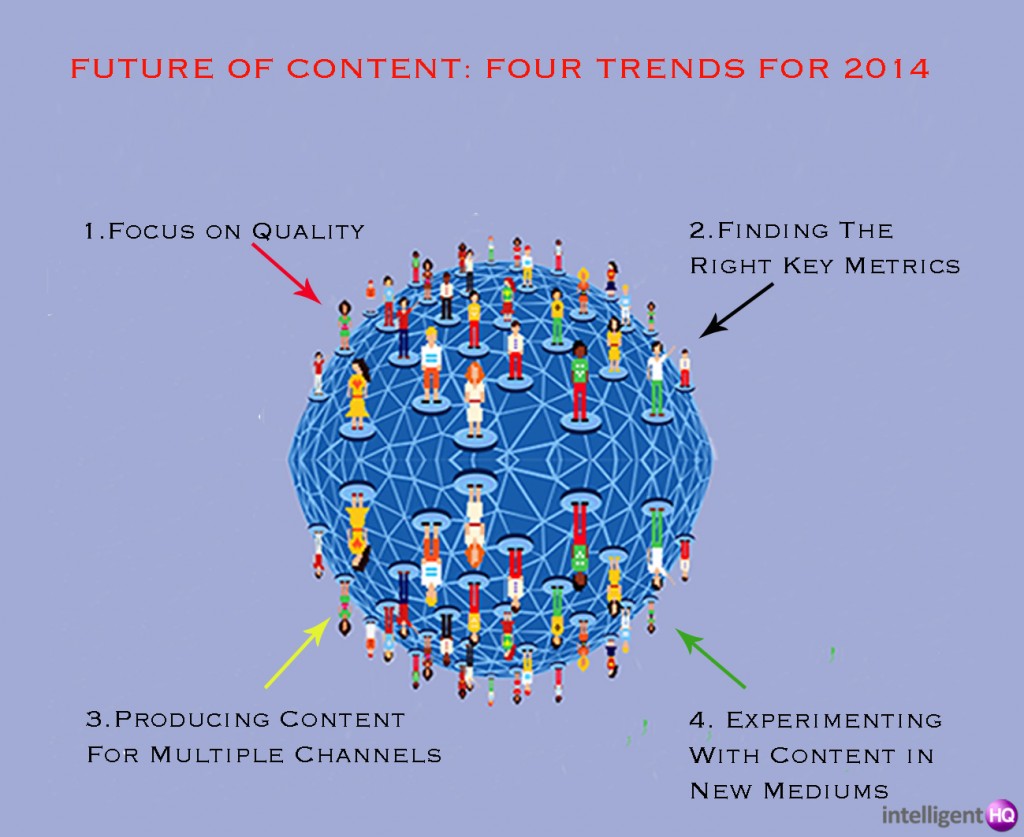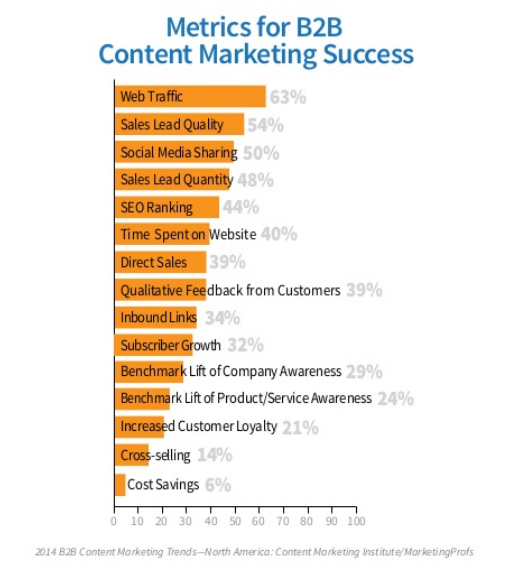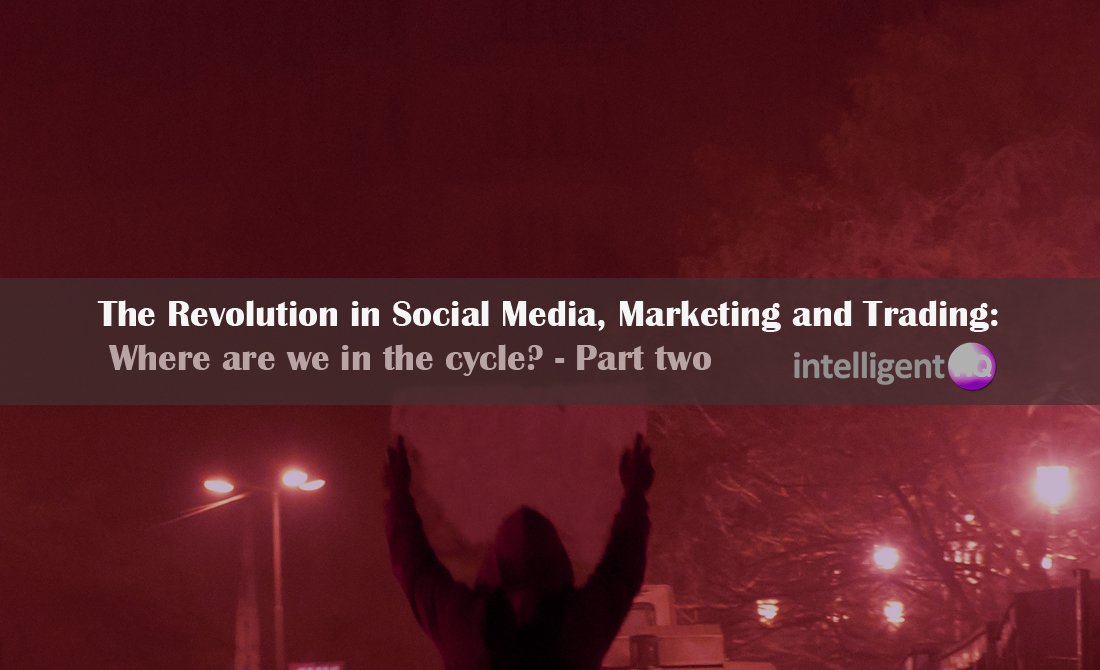 As nearly 3 billion people have now access to internet, we all have to be ready for the a big change: content is rapidly evolving, and the way consumers use it is changing at fast speed. Great changes will happen to the digital market space, but these will also bring new opportunities. What new trends can be traced for 2014, in terms of content marketers? Based on Stephanie Change´s article on Moz, one can say that there will be 4 trends for 2014:
As nearly 3 billion people have now access to internet, we all have to be ready for the a big change: content is rapidly evolving, and the way consumers use it is changing at fast speed. Great changes will happen to the digital market space, but these will also bring new opportunities. What new trends can be traced for 2014, in terms of content marketers? Based on Stephanie Change´s article on Moz, one can say that there will be 4 trends for 2014:
Trend 1 – It will Be More Difficult to Gain Consumers Attention – Focus on Quality
In the past it used to be enough to publish unique content on a regular basis on your site. Digital Media Publishers have now systems that produce great amounts of content at a very low price. But the quantity of content has skyrocketed last year. Take the example of The Huffington Post, that has 532 full-time editorial staff and produces at least 1200 pieces of content a day, having 43,3 million pageviews per day, or Forbes, that produces 400 (and it has 1000 contributors). Then we have the case of WordPress, that produces around 35.8 billion new posts each month. To write content regularly is not enough anymore. A small business will not be able to compete with these giants, so the only way to do it is to differentiate through the development of a content strategy. What is the company unique value proposition? What is your ideal customer? One possible strategy can be the one of generating personas. Personas are fictional characters created to represent your ideal customer. If the company doesn´t have a specific value proposition, it is wise to deeply reflect where are the opportunities in the space, to create one. For B2B companies, it is key to position your brand as the ultimate authority or source of knowledge in a specific industry/niche. To develop a solid content strategy is important to evaluate what are the characteristics of the product that the company is selling:
1. Is it a “think” product or a “feel” product?
A “think” product is one where a consumer heavily considers and researches before purchasing the product. A “feel” product is one where emotion plays a pivotal role in the buying process.
2. Does the consumer needs to be highly involved or not?
A “high involvement” product is one where the consumer is heavily involved in the buying decision. “Low involvement” products tend to err on a more impulsive or spur-of-the moment purchase.

Trend 2: Determining the right key metrics to measure content’s success will be more important
As we know the usual metrics to access the success of a piece of content has been traffic and page views. Even though it is obviously beneficial to have increased traffic (such as increased brand awareness and increased/potential revenue for publishers and bloggers), just to rely on these metrics can be deceiving. It is important to avoid headlines that promote clicks just for the sake of it, and to overuse keywords in a title just to have more page views. The main focus should be on creating content for users (which is building for the long term). It is essential to ask critically what are the main goals of the content being created: Is it to maintain an engaged community/develop brand advocates, build brand awareness, and/or to convert users into paying customers?
And what are the right metrics for an organization’s content? Looking at any metric in isolation can be misleading. Stephanie Change advice is to look for a combination of metrics of what we want to analyze and target. A key metric could be for example combining organic traffic + % returning visitors + tracking changes in bounce rate and time on site. Other types of businesses, can use social metrics, that can be a great conversion metric for content pieces. A Facebook like or a Twitter retweet signals some engagement, whereas a share, a comment, or becoming a “fan” of a Facebook page signals a potential brand advocate.

Trend 3: Increased interest in content integration (producing content for multiple channels)
According to Stephanie Change, the way to balance the resource limitations a company can face, with the need for innovation is to develop better integration methodologies. Integration Methodologies are increasingly important because consumers are changing the way they shop. According a study done by Accenture on global market research about the tendencies of 6,000 consumers in eight countries, particularly the Millennials, one of the top proposals for businesses was to provide consumers with a “seamless retail experience” which means an on-brand, personalized, and consistent experience regardless of channel. That continuous experience will require content to be deeply involved in various channels from online to in-person. When producing context for multiple channels, one is able to engage customers in one reliable conversation.
Another study cited by Stephanie Change is the Content Marketing Institute’s 2014 Report for B2B content marketers. This study indicates that B2B content marketers still view in-person events as their most effective tactic. The continuous transition of content from online marketing channels (via social media conversations, PPC and display ads, and content on the site via case studies and videos) to in-person conversations and consumer experience will definitely grow in importance in 2014.

Trend 4: Experimenting with content in new mediums
Technology is in constant and quick evolution. Content needs to be able to experiment with the new mediums technology provides, to reach their intended audiences. Marketers need to be able to adapt and scale very quickly to new trends and opportunities. The marketing agency, SapientNitro, released a 156-page free guide entitled Insights 2013 that talks in detail about some of these trends, such as in-store digital retail experiences, the future of television, sensors and experience design, and customer experience on the move to name a few. One of their detailed case studies is about Sephora. Sephora has developed great content in retail stores, such as several interactive kiosks that allow users to explore different fragrances or gain understanding about skincare. IPads surround the store that provide information on makeup tips and items can be scanned to reveal product information. Sephora’s mobile app has content that speaks to their core customer base and is in line with their other online and social media content. All of the content can be easily shared via email or through social networks.Other brands, such as Nivea mixed print advertising with mobile innovation. In this case, Nivea’s print ad also doubled as a solar ad charger for phones. Finally, PopTopia is a mobile game that has a mobile phone attachment, called Pop Dangle that will emit the smell of popcorn as you play the game. The game works because the attachment plugs into the audio jack and at a certain frequency, it will signal to spread the smell of popcorn. These examples all show brands who have embraced new mediums for the distribution of the companies content.
As seen, it looks that 2014 will bring stimulating change to content. Technological innovation can be used by marketers , as they need to adapt to the growing needs and expectations of their costumers in such a way that they will be surprised. Businesses need to have a clear unique value proposition. This is the essential basis from which marketing strategies and execution will grow in a fortuitous way for business.
More info about trends for content can be found here:
The future of Content Experience

Maria Fonseca is the Editor and Infographic Artist for IntelligentHQ. She is also a thought leader writing about social innovation, sharing economy, social business, and the commons. Aside her work for IntelligentHQ, Maria Fonseca is a visual artist and filmmaker that has exhibited widely in international events such as Manifesta 5, Sao Paulo Biennial, Photo Espana, Moderna Museet in Stockholm, Joshibi University and many others. She concluded her PhD on essayistic filmmaking , taken at University of Westminster in London and is preparing her post doc that will explore the links between creativity and the sharing economy.


























